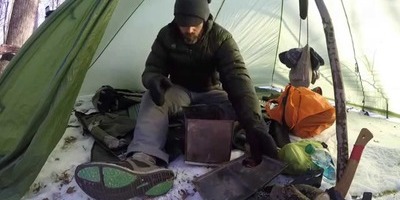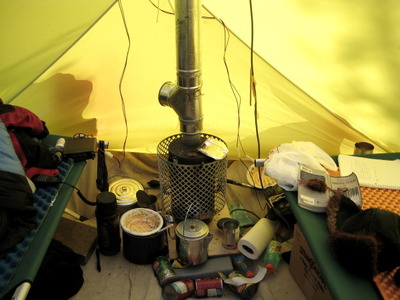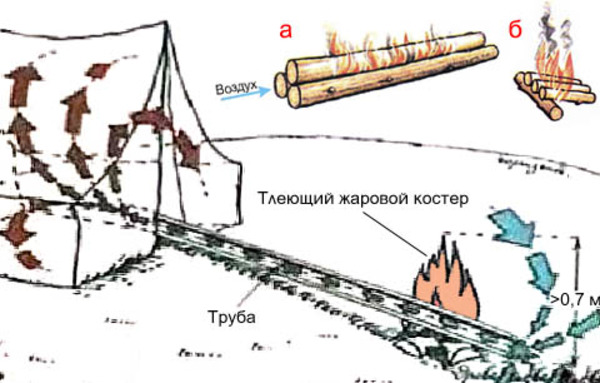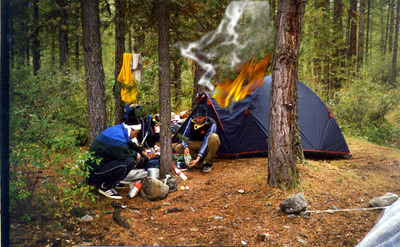Even in the forest you can spend the night with comfort! Dry-pipe system: a "stove" for a tent with your own hands

On a hike, the tent becomes shelter from bad weatherIt protects from moisture and wind, but in frosty weather even a good sleeping bag will not protect from the cold.
That's why lovers of nomadic recreation come up with various mobile heating systems.
Content
Types of heating for tents
Which tasks heating should solve:
- Heating and lighting tents in moderate frost without sleep. Ideal for fishermen - so that the holes do not freeze. Open fire systems are suitable - gas burner, multi-wick candle in a tin can casing, kerosene lantern "bat" with heat exchange nozzle. Some fishermen use catalytic heaters - one-time filled chemical ones on aluminum alum (do not provide a significant increase in heat).

Photo 1. When installing a metal stove in a tent, you need to ensure a safe chimney.
- Heating overnight accommodations during short hikes. A massive stainless steel metal stove or a gas infrared heater with a chimney will do.
- Heating tents with wood during long hikes. The main characteristics are lightness, reliability, absence of carbon monoxide, and the ability to use local fuel.
- Heating of tents in extreme conditions of mountain passes. The main thing here is lightness and efficiency. Gas burners with a tourist 5 liter cylinder.
Attention! Problem carbon monoxide — the main thing to pay attention to! Just three breaths lead to severe poisoning, loss of consciousness and death! Do not neglect common sense for the sake of momentary comfort.
Heating the tent depending on the location of the firebox can be internal and external.
- Internal Heating requires the removal of combustion products, as well as placing the stove in a confined space.
- External heating - transfer of temperature from the combustion source to the tent without the admixture of carbon monoxide.
Is it possible to install an energy-saving stove?

For a short winter hike, a potbelly stove is suitable made of thin-walled steel. It will heat a large tent, and transporting a heavy stove in winter is made easier by using a sled or drag.
She consists of a firebox and a chimney. The firebox door must provide regulation of combustion intensity, the entire structure must be sealed.
Frame ovens gets very hot. On the one hand, it is a plus, it is used as a camp stove to heat a kettle or food. The minus is the risk of fire. The wall of the tent near the stove should be covered with foil insulation, the valve at the outlet of the chimney is better made of heat-resistant fabric - a fire hose or a fireman's suit.
Install and heat such a stove Just — retractable legs are installed, the chimney is passed through the valve on the roof, and firewood is loaded.
Minus - short battery life, opportunity reverse smoking when throwing firewood and in strong winds, sparks from the pipe at high flame, relatively large weight.
Efficient heating with dry pipe system. Drawing
An original and proven method of heating can be dry pipe laid through the "Finnish candle" fire. If the tent is large, you can run the pipe into a fire or smoldering coal pit. This method is only gaining popularity, but it wins over others in simplicity, efficiency, safety and transportability.

Photo 2. Drawing of a tent heating system using a dry pipe system. Cold air moves through the pipe, heating up from the fire along the way.
How to make a dry pipe with your own hands: materials and tools
You won't need any special tools. Just saws for metal, files, sealants made of heat-resistant silicone.
It is better to use pipes aluminum rods from a vacuum cleaner and a bracket from a shell bed, which has a C-shaped form, which is ideal for installation in a "Finnish candle". All joints must be tight and open with noticeable effort.
How does the system work? Is the burning long?
Finnish candle - a fire inside a log. It is made like this: a log 50-70 cm long splits, with an axe the middle is chosen and kindling is put in its place. The log is collected and tied with wire. The candle is installed above the ground, the draft of burning gases passes through the burning channel. The intensity of combustion is regulated by the lid and the height of the installation.

You can adapt a Finnish candle to heat a tent, passing a pipe through the burning center logs. The pipe should be of a shaped form, the log is "put on" the vertical section.
Cold air is drawn in through the lower horizontal section, heated in a smoldering log and fed through an air duct into the tent.
In severe frosts, the air duct is better insulate with non-combustible basalt wool insulation. Then heat loss will be minimal.
Advantages this method of heating:
- Safety. The firebox is outside the tent, combustion products do not mix with the heated air. The possibility of fire or suffocation is practically excluded, and by extending the lower air duct, we move the air intake away from the combustion source.
- Ease of manufacture. Ready-made tubes that can be connected into sockets are available for sale.
- Transportability. The weight of the entire installation, including the axe, is total 2 kilograms.
- Versatility use. Wherever there is a log of a certain length, you can light a Finnish candle. The heartwood of the tree burns better - it has a certain moisture content.
- Duration burning log - from 3 to 6 hours depending on the thickness. This is quite enough to sleep in warmth.
What to consider when using dry pipes

When making a tent heater from a dry pipe passed through a Finnish candle, a simple fire or a coal pit, the following difficulties may arise:
- Inappropriate pipe diameter. The larger the tent, the larger the diameter of the pipes.
- Leaks at the joints pipes. Carbon monoxide gets in through them. The diameter is selected so that they fit perfectly tightly. There should be no joints inside the fire pit.
- The air intake is located too close to the fire. Ideally, it should be extended and brought out of the tent. Air exchange will be ideal, this will save heat.
- It is better to use as a heating pipe stainless steel 1-2 mm thick. The supply pipes are made of lighter materials aluminum or thin stainless steel.
- You can protect the fabric from fire by stretching it between the fire and the tent. screen of frozen wet gauze.
- To the fire did not lean or fall, it is advisable to prop it up or tie it to a support.
In descriptions of geologists' adventures, the method of heating a hut using clay pipes is considered a novelty. However, given the availability of a sealed dry-pipe system, this method You can heat a small two- or three-person tent.
Useful video
Watch a video demonstrating how to heat a tent using pipes and a fire.
Rules for using stoves in a tent
The tents are made made of flammable fabrics, and sometimes people do not have time to get out and get burned. Therefore, when heating, take all possible safety measures.

Beware of carbon monoxide poisoning, do not use questionable heating designs. Open flame in a tent burns oxygen and saturates the air with combustion products. To obtain light, use electric torch.
Prepare food on fire outside. If this is not possible, use infrared gas burners. They do not produce carbon monoxide or soot. Adjust ventilation mode.








